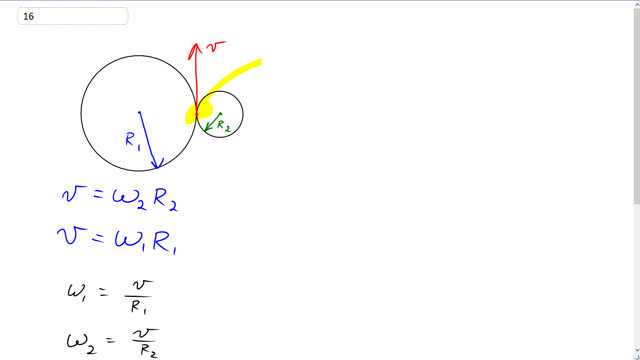
A turntable of radius is turned by a circular rubber roller of radius in contact with it at their outer edges. What is the ratio of their angular velocities, ?

In order to watch this solution you need to have a subscription.
This is Giancoli Answers with Mr. Dychko. This is the smaller rubber roller that is driving this larger turn-table and at this point of contact between them, they are both moving with the same tangental velocities. This point on the rubber roller and this point on the turn-table, they are not slipping and so there is static friction here, in other words, and that means that there's no rubbing and they are both moving with the same linear velocities. So that linear velocity according to the formula for the rubber stopper is the rubber stopper's angular velocity ω, we'll call it subscript 2, and multiplied by its radius R 2 and we don't have the subscript on the v because we just mentioned that the linear velocity of this point here is the same for both the turn-table and the rubber stopper so there's no need to put a subscript on the v. So this v again can be written as the angular velocity of the turn-table, ω 1 times its radius, R 1. And then we can solve for ω 1 and ω 2 from both of these equations so we have ω 1 is v over R 1 and then you could also say that ω 2 is v over R 2 and then divide these angular velocities in order to find the answer to our question here. So we have ω 1 over ω 2 is v 1 over R 2 divided by this but instead of dividing a fraction by a fraction, we'll multiply by the reciprocal of the denominator. So we'll multiply by R 2 over v and the v's cancel and we are left with R 2 over R 1 so ω 1 over ω 2 equals R 2 over R 1. And you know you should always do a reality check on your answers so let's see if this makes sense. This says that the angular velocity of this turn-table will increase as R 2 increases for example and that makes sense you know because if this rubber roller is really big then one rotation of it would rotate the turn-table a lot and the converse is true as well. So you know as shown in this picture, this rubber stopper is actually quite small so that means with a rotation of this rubber stopper, you would expect this turn-table to not move very much and if this rubber stopper was really, really, really small, it would have to have a really high angular velocity in order to make this turn-table move very much. So there you go, there's the answer.